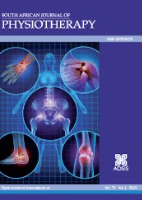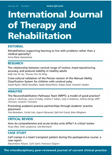
South African Journal of Physiotherapy
Scope & Guideline
Elevating Standards in Physical Therapy Education and Practice
Introduction
Aims and Scopes
- Clinical Rehabilitation:
The journal emphasizes clinical rehabilitation practices, including interventions for a range of conditions such as stroke, spinal cord injury, and musculoskeletal disorders, demonstrating the application of physiotherapy techniques in improving patient outcomes. - Public Health and Community Engagement:
Research that addresses public health issues, such as HIV-related disabilities and community-based rehabilitation, highlights the journal's commitment to promoting health equity and understanding the role of physiotherapy in community health. - Educational Research in Physiotherapy:
The journal publishes studies related to physiotherapy education, focusing on curriculum development, teaching methodologies, and the competencies required for effective practice in various settings. - Innovative Therapies and Technologies:
There is a consistent focus on novel therapeutic approaches, including the use of technology in rehabilitation (e.g., virtual reality therapy), and the exploration of new techniques such as inspiratory muscle training and posturography. - Psychosocial Aspects of Health:
The journal includes research that investigates the psychosocial factors affecting rehabilitation outcomes, such as the role of social support in physical activity and the mental health of physiotherapists.
Trending and Emerging
- Impact of COVID-19 on Physiotherapy Practice:
Several studies have emerged focusing on the implications of the COVID-19 pandemic on physiotherapy practices, including the adaptation of services and the mental health of practitioners, underscoring the profession's resilience and adaptability. - Community-Based Rehabilitation Initiatives:
There is an increasing emphasis on community-based rehabilitation, highlighting the importance of integrating physiotherapy into public health frameworks and addressing the needs of underserved populations. - Telehealth and Remote Interventions:
Research exploring telehealth and remote physiotherapy services has gained traction, particularly in the context of resource-constrained environments, showcasing the need for flexible service delivery models. - Holistic and Biopsychosocial Approaches:
An emerging trend is the adoption of holistic and biopsychosocial models in physiotherapy, examining how social, psychological, and physical factors interact in rehabilitation processes. - Focus on Health Equity and Social Determinants:
Recent publications have increasingly addressed health equity and the social determinants of health, particularly in relation to underserved communities, reflecting a growing awareness of the broader context in which physiotherapy operates.
Declining or Waning
- Scoliosis Management:
Research on scoliosis management techniques, while still relevant, has seen a decrease in new contributions, suggesting that established practices may be reaching a plateau in terms of novel findings or that researchers are moving towards more pressing issues. - Traditional Rehabilitation Techniques:
There appears to be a waning interest in traditional rehabilitation methods that do not incorporate modern technologies or evidence-based approaches, as newer, innovative methods gain prominence in research. - General Musculoskeletal Disorders:
While still an important area, the volume of studies specifically targeting general musculoskeletal disorders has decreased, perhaps as researchers focus on more specialized conditions or the integration of multidisciplinary approaches. - Palliative Care in Physiotherapy:
Research focusing on palliative care practices within physiotherapy has diminished, possibly reflecting a broader trend where the integration of physiotherapy into palliative care contexts is becoming less emphasized in favor of other pressing health issues.
Similar Journals

Physiotherapy Canada
Elevating Physiotherapy Knowledge for Professionals and ScholarsPhysiotherapy Canada, published by University of Toronto Press Inc., is a premier academic journal dedicated to advancing the field of physical therapy, sports therapy, and rehabilitation. Established in 1973, this journal has become a vital resource for researchers and clinicians alike, offering a platform for scholarly articles that address contemporary challenges and innovations in physiotherapy practice. With a current Scopus rank of #144 out of 247 in its category, placing it in the 41st percentile, Physiotherapy Canada is recognized for its contributions to the field, featuring original research, case studies, and reviews that echo the wide-ranging interests of its audience. Although it does not operate under an open-access model, the journal remains committed to disseminating crucial knowledge that informs and inspires both professional practice and academic inquiry. The journal’s ongoing commitment to quality scholarship ensures that it plays an essential role in shaping the future of physiotherapy in Canada and beyond.

European Journal of Physical and Rehabilitation Medicine
Pioneering Progress: Your Resource for Evidence-Based RehabilitationWelcome to the European Journal of Physical and Rehabilitation Medicine, the premier peer-reviewed journal focusing on advancements in the fields of physical therapy, sports therapy, and rehabilitation. Published by EDIZIONI MINERVA MEDICA, this journal has established itself as a leading resource since its inception in 2008, now enjoying an impressive Q1 ranking in these disciplines according to 2023 metrics. With an emphasis on rigorous research and innovative clinical practice, the journal facilitates the dissemination of high-quality, evidence-based studies, contributing to the enhancement of patient care and therapeutic strategies. As an Open Access platform since 2022, the journal widens its reach, enabling researchers, clinicians, and students across the globe to access valuable insights without barriers. Residing in Italy, the journal's focus transcends regional confines, engaging a vibrant international community aimed at improving rehabilitation outcomes. Join us in exploring the latest developments that shape the future of rehabilitation sciences.

Journal of Human Sport and Exercise
Fostering excellence in sports therapy and rehabilitation research.The Journal of Human Sport and Exercise is a premier open access journal published by UNIV ALICANTE since 2006, providing a vital platform for the dissemination of cutting-edge research in the fields of Physical Therapy, Sports Therapy, Rehabilitation, and Sports Science. With its ISSN 1988-5202 and E-ISSN 1988-5202, the journal promotes high-quality research that drives advancements in human performance and well-being. The journal has an impact factor indicative of its contributions, currently categorized in Q3 for Physical Therapy, Sports Therapy, and Rehabilitation, alongside Q4 in Sports Science as of 2023. It holds a Scopus rank of #133 out of 247 in the Health Professions category, reflecting its commitment to academic excellence. With converged years from 2010 to 2024, it aims to foster a collaborative environment for researchers, professionals, and students alike, seeking to explore the intersections of sports, health, and exercise. Based in Spain, the journal's open access policy ensures that valuable research is freely available, amplifying its reach and impact across the global academic community.

Journal of Physiotherapy
Unleashing Potential: Your Gateway to Physiotherapy ExcellenceThe Journal of Physiotherapy, published by the Australian Physiotherapy Association, is a leading peer-reviewed journal dedicated to advancing the field of physical therapy, sports therapy, and rehabilitation. With a stellar impact factor and ranked Q1 in the 2023 category of Physical Therapy, this journal serves as an essential resource for researchers, clinicians, and educators alike. Located in Australia, it features open access options that allow global dissemination of knowledge, enhancing the visibility of cutting-edge research from 2010 to 2024. With a commendable Scopus Rank of #5 out of 247 in its field, achieving the 98th percentile, the Journal of Physiotherapy is committed to enriching the evidence base within the profession and promoting best practices in physiotherapy. Whether you are searching for the latest clinical studies, innovative treatments, or comprehensive reviews, this journal provides a platform for high-quality scholarship that drives the profession forward.

International Journal of Therapy and Rehabilitation
Exploring New Horizons in Therapy and RehabilitationInternational Journal of Therapy and Rehabilitation (ISSN: 1741-1645; E-ISSN: 1759-779X), published by MA HEALTHCARE LTD, is a premier platform for disseminating innovative research and clinical practices in the fields of physical therapy, sports therapy, and rehabilitation. As an influential contributor to the academic discourse in rehabilitation, this journal holds a notable impact factor and is recognized in the Q4 category in Physical Therapy, Sports Therapy and Rehabilitation and Q3 in Rehabilitation as of 2023. With rankings of #112 out of 161 and #190 out of 247 in Scopus, respectively, it remains committed to publishing high-quality research that addresses both the fundamental and contemporary challenges in therapy and rehabilitation. While the journal does not offer open access, it strives to present content that is highly relevant and impactful for practitioners, researchers, and students in the healthcare community. The journal's scope, spanning from 1996 to 2024, reflects its dedication to reflecting the evolving nature of therapy and rehabilitation practices globally.

International Journal of Physiotherapy
Advancing Rehabilitation: Bridging Knowledge and PracticeThe International Journal of Physiotherapy, published by IJPHY Publishers, is a distinguished platform committed to advancing the field of rehabilitation sciences and physiotherapy. With an ISSN of 2349-5987 and E-ISSN of 2348-8336, this Open Access journal has been facilitating global knowledge sharing since 2014. Located in the culturally rich city of Tirupati, Andhra Pradesh, India, the journal aims to provide comprehensive research findings, innovative therapeutic techniques, and insightful reviews in physiotherapy, thus catering to academics, clinicians, and researchers alike. By allowing unrestricted access to its content, the journal promotes the dissemination of evidence-based practices, thereby enhancing the quality of care and fostering professional development in the field. With a growing repository of scholarly articles and a commitment to maintaining high publication standards, the International Journal of Physiotherapy is poised to become an essential resource for anyone dedicated to the pursuit of knowledge in physiotherapy and rehabilitation.

Frontiers in Sports and Active Living
Fostering interdisciplinary dialogue for active living advancements.Frontiers in Sports and Active Living, published by FRONTIERS MEDIA SA, is a pioneering open-access journal that has been at the forefront of research since its establishment in 2019. Operating from its prestigious base in Lausanne, Switzerland, this journal stands out with its commitment to disseminating cutting-edge research across various disciplines, including Anthropology, Orthopedics and Sports Medicine, and Public Health, among others. With consistently high rankings—achieving Q1 status in its category for Anthropology and Q2 in several related fields—it serves as an essential resource for scholars and practitioners alike. The journal's open-access model not only enhances visibility but also fosters collaboration and innovation in the domains of physical therapy, sports therapy, and rehabilitation. As it continues to evolve, Frontiers in Sports and Active Living strives to provide a vibrant platform for academic excellence, encouraging interdisciplinary dialogue that can significantly advance our understanding of active living and its impacts on health and society.

Physiotherapy Practice and Research
Connecting research and practice for better health outcomes.Physiotherapy Practice and Research is a pivotal journal published by IOS PRESS that focuses on the dynamic field of rehabilitation and physiotherapy. Since its inception in 2009, this journal has provided a scholarly platform for researchers, clinicians, and students to disseminate innovative findings and practical applications in occupational therapy, sports medicine, and rehabilitation sciences. Although the journal currently holds Q3 and Q4 rankings in several categories, including occupational therapy and physical therapy, its impact in fostering research collaboration and informing practice is becoming increasingly important in advancing patient care and rehabilitation outcomes. With an ongoing commitment to open-access principles, the journal welcomes original research and review articles that address contemporary challenges and emerging practices within the field. As the journal continues to evolve, it aims to engage more deeply with the global research community, unlocking vital discussions that shape the future of physiotherapy.

Physiotherapy
Empowering Professionals with Cutting-Edge KnowledgePhysiotherapy, published by Elsevier Science Ltd, stands as a prestigious journal in the field of Physical Therapy, Sports Therapy, and Rehabilitation. Since its inception in 1945, this journal has been committed to advancing the practice and science of physiotherapy through rigorous peer-reviewed research, making significant contributions to both clinical practice and academia. With an impressive Q1 ranking and a Scopus percentile of 88th, it is widely regarded as a leading source of evidence-based information for professionals and researchers alike. The journal operates without an Open Access option, which ensures that it maintains the quality and integrity of the research it publishes while providing exclusive access to valuable insights for its subscribers. By focusing on diverse topics within its scope, including therapeutic techniques, rehabilitation strategies, and sports medicine, Physiotherapy continues to shape the future of physiotherapy practice and education, making it an essential resource for anyone invested in this dynamic field.

PHYSIKALISCHE MEDIZIN REHABILITATIONSMEDIZIN KURORTMEDIZIN
Transforming Lives Through Cutting-Edge Research in RehabilitationPHYSIKALISCHE MEDIZIN REHABILITATIONSMEDIZIN KURORTMEDIZIN, published by GEORG THIEME VERLAG KG, is a prominent journal dedicated to the fields of physical medicine, rehabilitation, and resort medicine. With its ISSN of 0940-6689 and E-ISSN 1439-085X, this journal has been at the forefront of disseminating essential research and innovative practices since its inception. Operating from Germany, it offers a crucial platform for professionals, researchers, and students engaged in exploring the latest advancements in rehabilitation methodologies and therapeutic practices. Although it currently holds a Q4 ranking in several categories including Physical Therapy and Rehabilitation, the journal is committed to enhancing its impact and visibility within the academic community. The journal publishes research, reviews, and clinical studies aimed at improving patient outcomes and advancing the science of rehabilitation. Subscribers can expect high-quality content that addresses both theoretical and practical aspects of rehabilitation medicine, ultimately contributing significantly to ongoing discussions and developments in the field.